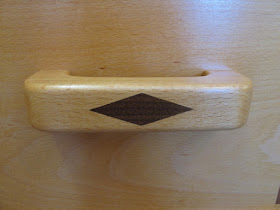 |
| Walnut veneer diamond match lid |
Opening the lid reveals the compass rose veneer inlay, which is Makasar Ebony and Cherry. Notice the grain direction in the inlay, it makes the tips of the veneer easy to break. The diamond inlays to the left and right are Walnut burl with a black Ebony border.
 |
| Compass rose veneer inlay, Makasar Ebony and Cherry |
All the dovetails are hand cut and all the mitres have hand cut walnut keys. The lid has a dovetailed key. Adding this final detail to the lid tested my nerves, however these keys help strengthen the mitres by adding a side grain glue surface.
 |
| Walnut key |
This is the detail in the bottom skirting. My dovetail saw made the perfect kerf for the Walnut veneer.
I originally fitted the chest with brass handles, but after a couple of years I changed them out for a more heavy duty wood handle. The diamond is 5mm thick solid Walnut. I wanted the diamond to have fine tips, so after routering out the recess in the Beech I had to use a very fine carving knife to refine the tips. Then of course I had to cut and fit the walnut diamond. I milled a piece of 6mm thick Walnut and prepared myself for a tedious fitting process. Fortunately the opposite happened. I marked four layout lines on the Walnut and made four cuts with my gents saw. The fit was perfect. I did both inlays with no fuss at all. Just don’t ask me to do it again.
 |
| Walnut diamond detail |
The removable trays and saw till are made from Honduran Mahogany and all have tiny single-kerf dovetails. Most of the tools have been French fit.
I hope someday to make a matching lower cabinet with larger drawers to take the lift out trays, maybe when I retire. For now the chest sits on a temporary pine stand. I designed the built in cabinets in my shop to take the lift out tool trays. My planes that sit in the bottom of the tool chest are then easily accessible as I work. I really enjoyed making this project. My advice to the hobby woodworker is to build projects that you feel inspired and motivated to make. They don’t always have to be technically challenging. After making this tool chest I built a bunch of birdhouses for my Mother’s garden and loved every minute of it. I have another tool chest that I use every day in my “real job” as a cabinetmaker. I will give everyone a closer look in a later blog. I definitely have a thing for tool chests and making little homes for my tools. If you are a woodworker who does your rough milling with machinery and then uses hand tools for your final details, then I would recommend making a smaller machinist/patternmakers style chest and then a larger rolling cabinet for it to sit on. Drawers are definitely a more effective use of space and make all of those smaller tools easier to access.





